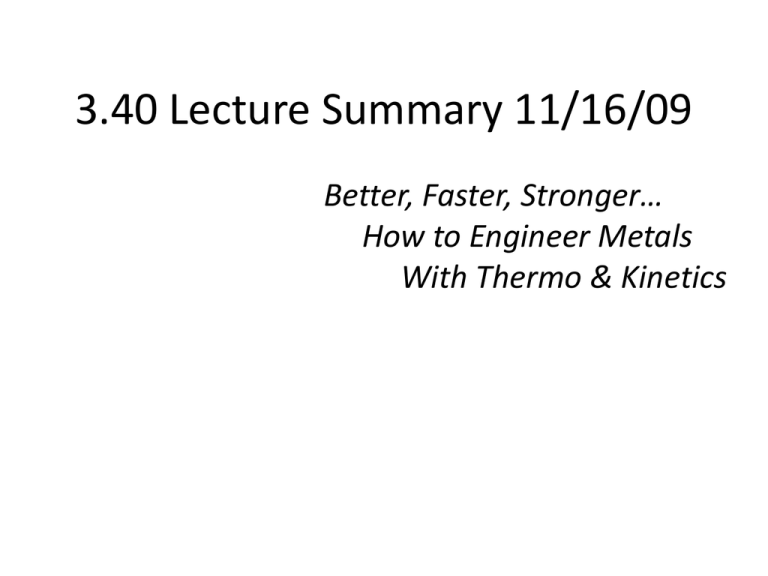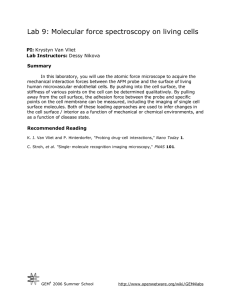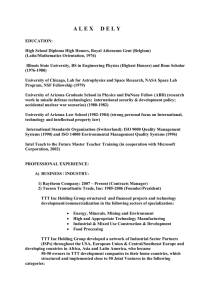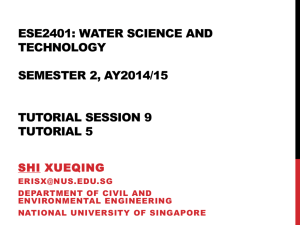3.40 Lecture Summary 11/16/09 Better, Faster, Stronger… How to Engineer Metals
advertisement

3.40 Lecture Summary 11/16/09 Better, Faster, Stronger… How to Engineer Metals With Thermo & Kinetics Contributions to Precipitation Hardening • Particle Size – Shearablility – Coherency • Ordering • Modulus • Volume Fraction cutting bowing coherent incoherent rrc-b c-b rc-ir Courtesy of Krystyn Van Vliet. Used with permission. Coherency: Lattice strain Please see Fig. 3.47c in Porter, D., and K. Easterling. Phase Transformations in Metals and Alloys Boca Raton, FL: CRC Press, 2009. Coherent with Strain D. Porter, K. Easterling. Phase transformations in metals and alloys. CRC Press 2000. http://www.matsceng.ohio-state.edu/mse205/lectures/chapter10/index_chap10.htm Courtesy of DoITPoMS, University of Cambridge. Used with permission. Contributions to Precipitation Hardening • Particle Size – Shearablility – Coherency • Ordering • Modulus • Volume Fraction coherent incoherent rc-b rc-irc-i Courtesy of Krystyn Van Vliet. Used with permission. How do we engineer metals for maximum strength? Simple: Large number of particles with r=rc-b http://www.matsceng.ohio-state.edu/mse205/lectures/chapter10/index_chap10.htm Thermodynamics: Phase Diagrams What do we want? Intermetallic: Ordered phase Large Vf Atomic percent tellurium 1000 0 10 20 30 40 50 60 70 80 90 100 924oC 900 C0 L Temperature oC 800 700 T1 PbTe 600 500 449.57oC o 410.9 C 400 83.4 326.8oC o 327.502 C T 300 2 200 Figure by MIT OpenCourseWare. Adapted from Vol. 3, Alloy Phase Diagrams, ASM Handbook. Materials Park, OH: ASM International, 2009. 0 Pb 10 20 30 40 50 60 Weight percent tellurium 70 80 90 100 Te Please see "Microstructural Development: Basic Requirements for Aging. aluMATTER, University of Liverpool." W. Hosford. Physical Metallurgy CRC Press, 2005 Thermodynamics: Phase Diagrams Tie-Line Construction i Vf i ii Atomic percent tellurium 1000 0 10 20 30 40 50 60 70 80 900 L Temperature oC 800 700 T1 PbTe 600 500 410.9o 400 327.502 C T 300 2 200 449.57oC C 83.4 326.8oC o W. Hosford. Physical Metallurgy CRC Press, 2005 100 924oC C0 Figure by MIT OpenCourseWare. Adapted from Vol. 3, Alloy Phase Diagrams, ASM Handbook. Materials Park, OH: ASM International, 2009. 90 (ii) (i) 0 Pb 10 20 30 40 50 60 Weight percent tellurium 70 80 90 100 Te Please see "Microstructural Development: Basic Requirements for Aging. aluMATTER, University of Liverpool." What about particle size: Kinetics What do we want? Large Vf of optimum particle size Temperature T0 T2 Solution Heat Treatment Quench Image removed due to copyright restrictions. Please see Fig. 12-7 in Askeland, Donald R., and Pradeep Prabhakar Phulé.' The Science and Engineering of Materials. Stamford, CT: Cengage Learning, 2008. Precipitation Heat Treatment T1 Time Used with permission. Please also see "Microstructural Development: Stages of Heat Treatment." aluMATTER, University of Liverpool. http://www.uic.edu/classes/cemm/cemm470/Heat%20Treatment%20of%20Steels%20and%20Metallic%20Materials%5B1%5D.pdf Precipitation Hardening: Kinetics Inc. Vf t rave rnuc coherent incoherent t rc-b rc-i Courtesy of Krystyn Van Vliet. Used with permission. Δτ r t Precipitation Hardening: Kinetics Inc. Nuc. Vf t rave rnuc coherent incoherent t rc-b rc-i Courtesy of Krystyn Van Vliet. Used with permission. Δτ r V Precipitation Hardening: Kinetics Vf,eq Inc. Nuc. Growth Vf t rave coherent incoherent rc-b rc-b rc-i Courtesy of Krystyn Van Vliet. Used with permission. r~t1/2 rnuc t Δτ r V V r t Large contribution to strengthening: Volume fraction and radius increasing Precipitation Hardening: Kinetics Vf,eq Inc. Nuc. Growth Ostwald ripening Via Thermo. tie line Not impingement! Vf t rc-i rave coherent incoherent r~t1/3 rc-b rc-b rc-i r~t1/2 Courtesy of Krystyn Van Vliet. Used with permission. rnuc t Sweet Spot for Max Strengthening: rc-b & Vf,,eq Δτ r V V r r t Gibbs-Thompson Effect: Ostwald ripening Images removed due to copyright restrictions. Please see: Fig. 15.1c in Balluffi, Robert W., et al. Kinetics of Materials. Hoboken, NJ: Wiley-Interscience, 2005. Fig. 10.20 in Hosford, William F. Physical Metallurgy. Boca Raton, FL: CRC Press, 2005. Curvature affects free energy diagram solubility in smaller particles Established concentration gradient Large grow, small shrink R. Balluffi, S. Allen, C. Carter. Kinetics of Materials. Hoboken, NJ: J. Wiley & sons. 2005 W. Hosford. Physical Metallurgy CRC Press, 2005 Time-Temperature-Transformation Diagram (TTT) Plots representing the level of transformation (in %) during an isothermal process from nonequilibrium conditions to equilibrium vs. time TTT diagram Please see "Underlying Metallurgy: Transformation Diagrams (CCT & TTT)." SteelMATTER. University of Liverpool, 2000. Shape of the TTT diagram • Existence of a nose: competing mechanism • High T favorable to diffusion > growth dominated • Low T favors nucleation as the driving force (difference in free energy G) is large TTT diagram has a nose separating growth dominated from nucleation dominated regions TTT continued Growth dominated Nucleation dominated Image from Wikimedia Commons, http://commons.wikimedia.org. How does strength evolves with time at constant T? 1) Bell-shape curve 2) Fastest at Tnose Strength vs. time Tnose= T3 How does strength evolves with time at constant T? 1) Bell-shape curve 2) Fastest at Tnose 3) If T is high, Vf is getting smaller (lever rule) > few precipitates + before coarsening <r> > rc/b Temperature (C) Phase Diagram Composition (%) Courtesy of DoITPoMS, University of Cambridge. Used with permission. http://www.doitpoms.ac.uk/tlplib/phase-diagrams/lever.php if T is high, <r> at the end of growth http://upload.wikimedia.org/wikipedia/en/6/63/Strengtheningg.png Strength vs. time Tnose= T3 Tnose= T3 3 T4 >T4T>T nose How does strength evolves with time at constant T? 1) Bell-shape curve 2) Fastest at Tnose 3) If T is high, Vf is getting smaller (lever rule) > few grain + before coarsening <r> > rc/b 4) If T is low, nucleation is dominating, lots of small grain: <r> < rc/b if T is low, <r> at the end of growth http://upload.wikimedia.org/wikipedia/en/6/63/Strengtheningg.png Strength vs. time Tnose= T3 T1 >T3 T4 >T3 How does strength evolves with time at constant T? 1) Bell-shape curve 2) Fastest at Tnose 3) If T is high, Vf is getting smaller (lever rule) > few grain + before coarsening <r> > rc/b 4) If T is low, nucleation is dominating lots of small grain: <r> < rc/b There is an optimal temperature for maximum strengthening at <r> = rc/b Strength vs. time Tnose= T3 T2: optimal for strengthening, experimentally a little above Tnose T4 >T3 T1 < T3 RT=T1 Refinements • Take into account aging during service • Non metallic precipitates e.g. VC in Fe-V-C • Core-shell e.g. Zr around Al3Sc Zr shell impedes diffusion thus growth Al3Sc precipitate Courtesy of Elsevier, Inc., http://www.sciencedirect.com. Used with permission. • Particle alignment (coherency stress) e.g. Ni3Al in Ni-Al • Extrinsic nanoparticles seeding > no growth, no shear MIT OpenCourseWare http://ocw.mit.edu 3.40J / 22.71J / 3.14 Physical Metallurgy Fall 2009 For information about citing these materials or our Terms of Use, visit: http://ocw.mit.edu/terms.




